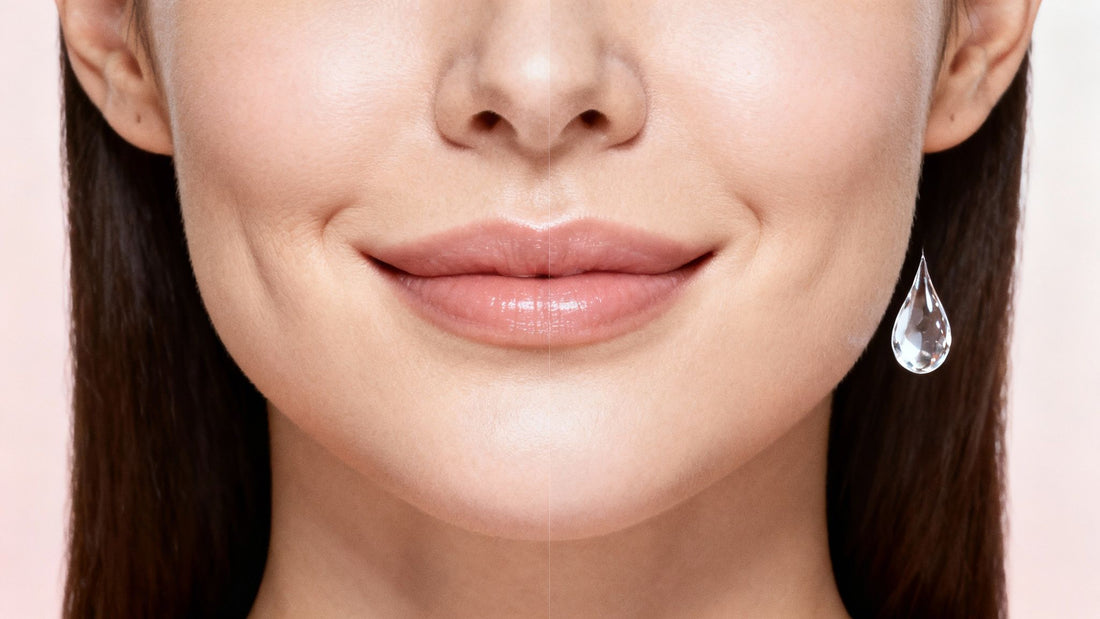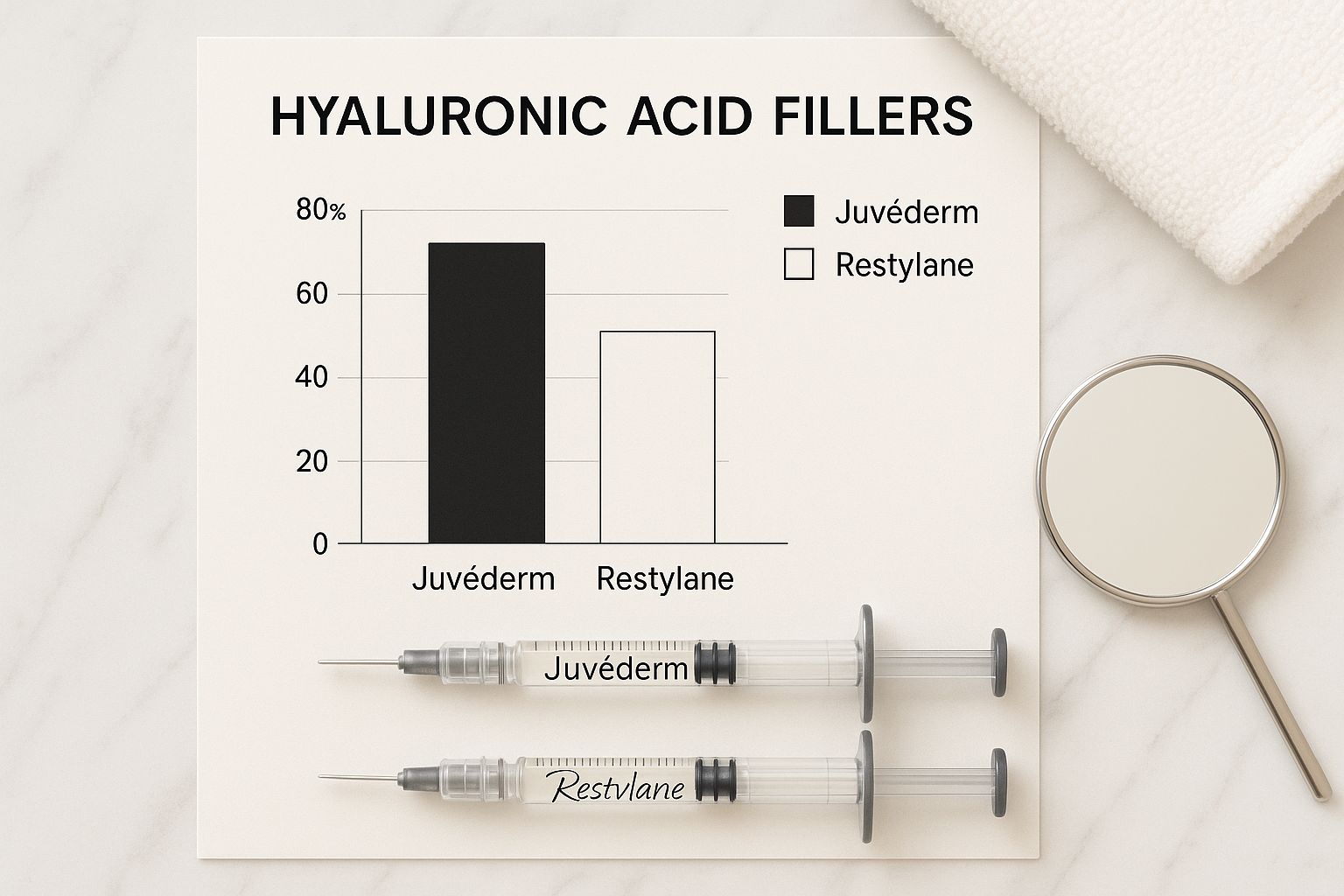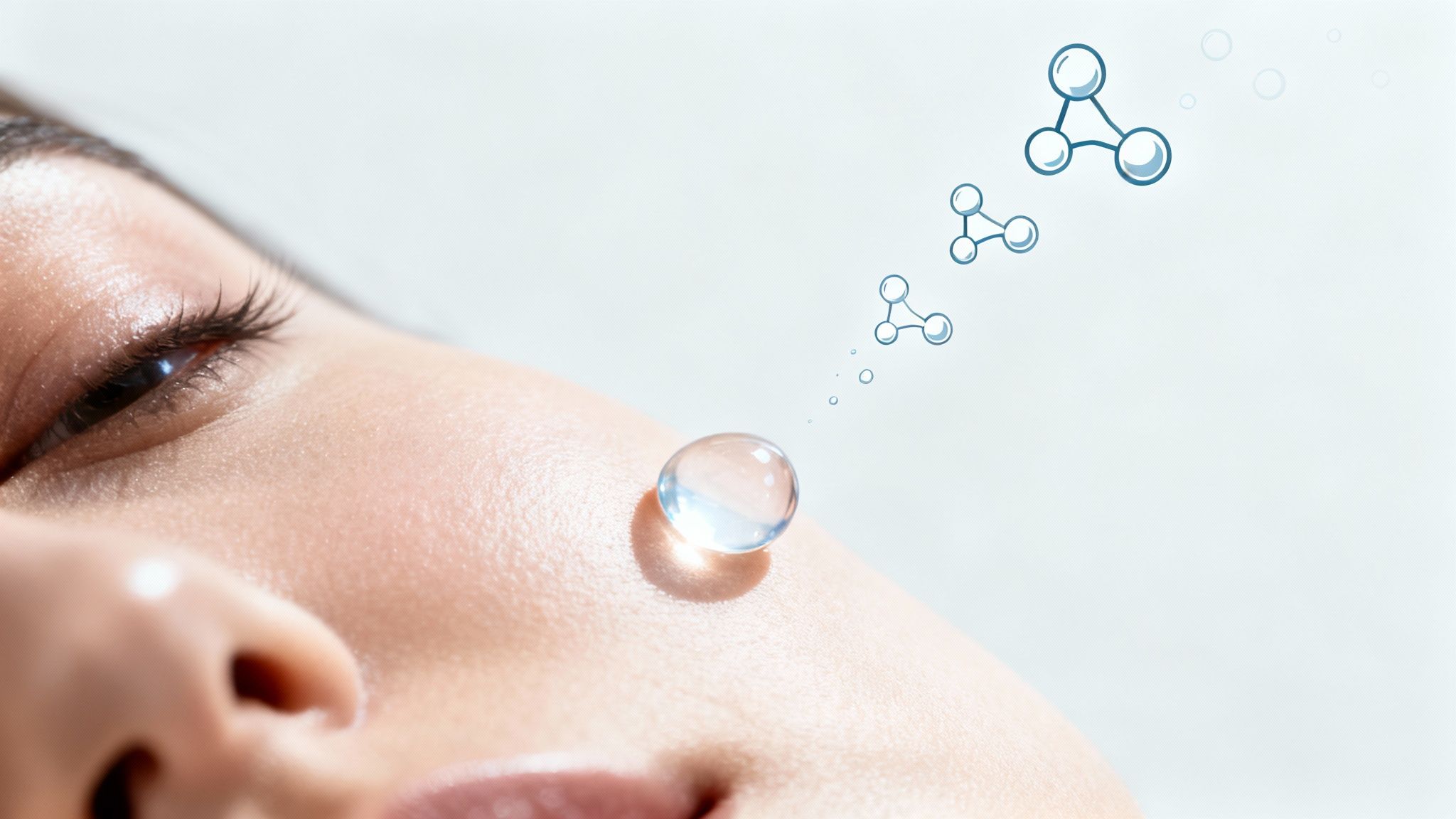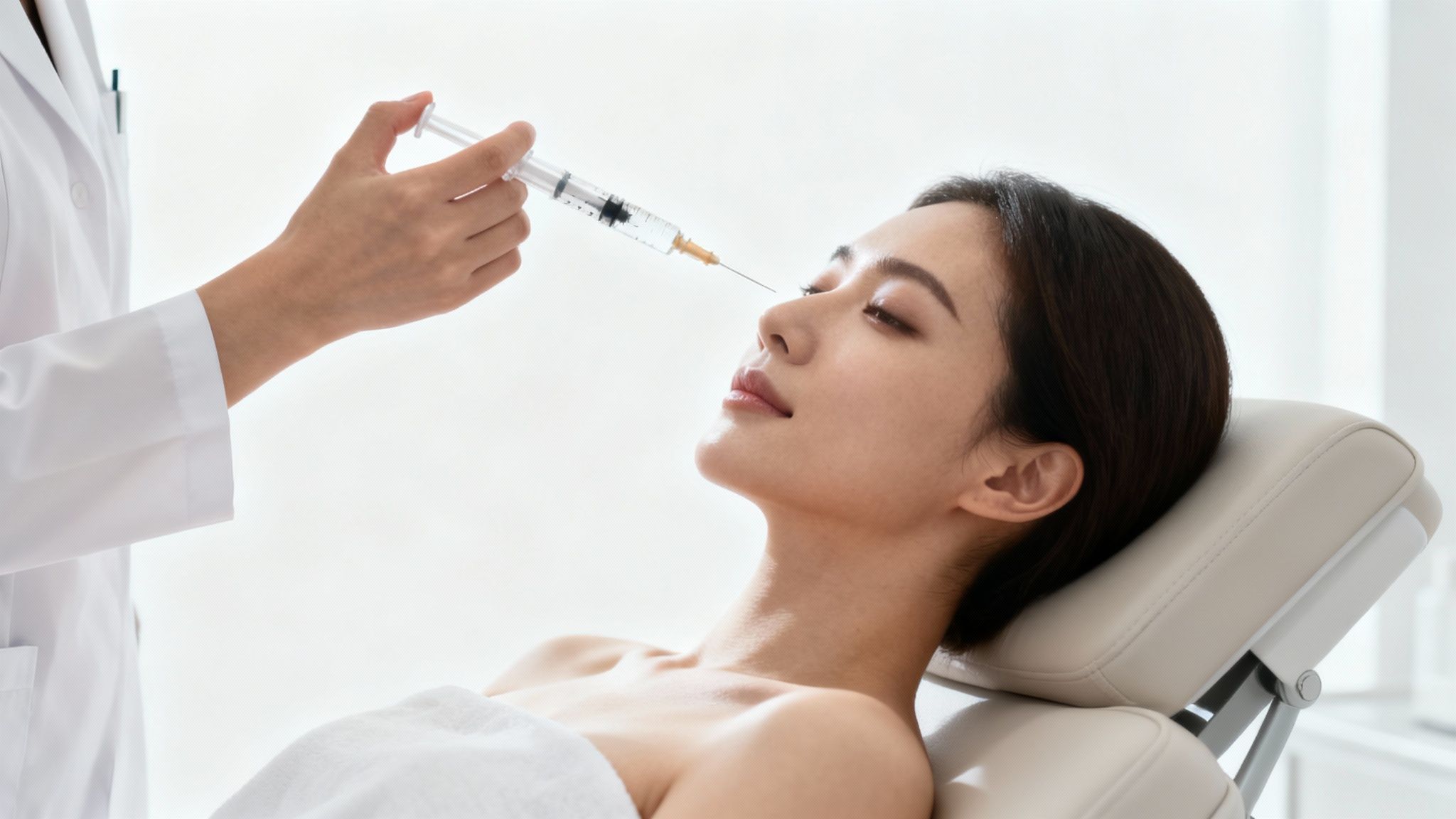
When it comes to the best fillers for smile lines, the answer from experienced injectors is almost always the same: Hyaluronic Acid (HA) fillers. Brands like Juvéderm and Restylane are the trusted go-to's for a reason. They have an incredible ability to safely restore lost volume in the nasolabial folds, smoothing the skin for a refreshed, natural look that never looks "done."
Understanding the Top Choice for Smile Lines
Those lines that run from the sides of your nose to the corners of your mouth? We call them smile lines, or nasolabial folds. They’re a completely natural part of aging and expressing joy, but they tend to deepen over time as our skin loses its youthful scaffolding—collagen, elastin, and fat.
This is where dermal fillers come in as a simple, effective solution to soften their appearance.
The magic of HA fillers is that hyaluronic acid is something your body already makes. Think of it as a tiny, powerful moisture magnet. When injected, it draws water to the treatment area, instantly plumping the skin from the inside out. It's not just filling a crease; it's rehydrating and supporting the tissue right where you need it.
Why Hyaluronic Acid Is the Leading Solution
The numbers don't lie. The global market for dermal fillers is projected to hit around $7.24 billion in 2025, and HA fillers dominate the field, accounting for a massive $5.27 billion of that. This isn't just a trend; it's a testament to their reliability and how happy patients are with their results.
Here’s a quick breakdown of why HA fillers are the undisputed champion for treating smile lines:
- Safety First: Because HA is already found in your body, the risk of an allergic reaction is incredibly low. Your body recognizes it and welcomes it.
- An 'Undo' Button: Not 100% in love with your results? No problem. An enzyme called hyaluronidase can be injected to dissolve the filler quickly and safely.
- Subtle & Natural: In the hands of a skilled injector, HA fillers create beautifully subtle enhancements. You’ll still look like you—just a smoother, more rested version.
The image below gives you a glimpse of the two leading HA brands injectors trust to get the job done right.

These are the tools we use to expertly restore volume and soften those nasolabial folds. To get a broader look at how different fillers are used across the face, you might find our guide on the best facial fillers helpful. And remember, finding an expert in your area is key; for those in California, a dedicated resource for Los Angeles Dermal Fillers can point you in the right direction.
Top Hyaluronic Acid Fillers for Smile Lines at a Glance
Navigating the world of HA fillers can feel overwhelming with all the different brand names out there. To simplify things, here's a quick comparison of the most popular and effective options specifically chosen for nasolabial folds.
| Filler Brand | Key Ingredient | Primary Benefit for Smile Lines | Typical Longevity |
|---|---|---|---|
| Juvéderm Vollure XC | Hyaluronic Acid | Blends flexibility and support, ideal for expressive areas. | Up to 18 months |
| Restylane Refyne | Hyaluronic Acid | Offers great flexibility, moving naturally with your smile. | Up to 12 months |
| Restylane Defyne | Hyaluronic Acid | Provides more structure for deeper folds while maintaining expression. | Up to 12 months |
| Juvéderm Ultra Plus XC | Hyaluronic Acid | A robust, thicker gel perfect for significant volume loss. | Around 12 months |
Each of these fillers has a slightly different personality, so to speak. Your injector will help you choose the one whose properties best match your unique anatomy and aesthetic goals, ensuring a result that looks and feels completely natural.
How Hyaluronic Acid Fillers Work

To really get why hyaluronic acid (HA) is the star ingredient for smile line fillers, think of a dry sponge. The moment you add water, it instantly plumps up, becoming soft and full. That’s almost exactly what HA does inside your skin.
Hyaluronic acid is a sugar molecule your body already makes. Its main job? To grab onto water and hold it tight. When an expert injector places an HA filler into the nasolabial folds, it acts like a tiny moisture magnet, pulling hydration right where it's needed. This immediately brings back lost volume and adds structural support from underneath. A great way to support this internal hydration is with a topical serum like the BARB N.P. HA Pep Smoothing & Hydrating Serum, which moisturizes the skin's surface.
The result is a gentle lift that smooths out smile lines without making you look unnatural or "frozen." It’s not about erasing your expressions—it’s about reinforcing the skin that frames your beautiful smile. For a closer look at the science, check out our guide on how dermal fillers work.
A Formula for Every Fold
Just like no two smiles are the same, not all smile lines are identical. That's why top-tier brands like Juvéderm and Restylane have created an entire portfolio of HA fillers, each with its own personality designed for everything from faint, delicate lines to deeper, more established folds.
You can think of these different formulas like fabrics. Some are soft and flexible, like silk, perfect for areas with a lot of movement. Others are thicker and more structured, like denim, ideal for providing a serious lift.
The secret is a process called cross-linking, where individual HA chains are linked together. The amount of cross-linking is what dictates the filler's thickness, its firmness, and ultimately, how long it will last in the body.
This is what allows a skilled provider to truly customize your treatment. They’ll assess your unique facial structure and the specific character of your smile lines to pick a filler that will blend in seamlessly.
Matching the Filler to the Line
It's no surprise that these treatments are becoming more and more popular. The dermal filler market hit an estimated $6.78 billion in 2024 and is projected to almost double by 2032. This growth is all about the demand for safe, natural-looking results, with North America claiming over 42% of the HA filler market.
So, how does a provider choose the right one for you?
- For Softer, More Flexible Lines: If your smile lines are most noticeable when you're expressive, you need a filler that can move with you. Products like Restylane Refyne and Juvéderm Vollure are engineered for flexibility, preventing any stiffness. They’re perfect for subtle correction of mild to moderate lines.
- For Deeper, More Structural Folds: When volume loss is more significant, you need a filler with enough backbone to lift the tissue. Restylane Defyne gives amazing support while still allowing for natural facial movement, while Juvéderm Ultra Plus is a more robust gel designed to correct deeper creases.
Understanding these distinctions is key. It empowers you to have a better, more productive conversation with your injector, making sure you’re both on the same page and working toward the same beautiful, refreshed result.
Exploring Other Types of Dermal Fillers
While Hyaluronic Acid (HA) fillers are the go-to for many smile lines, they aren't the only tool in an expert injector's kit. Sometimes, you need more than just a simple "fill." For deeper folds and more significant volume loss, we often turn to a different class of advanced fillers known as biostimulatory fillers.
Think of them less as a filler and more as a personal trainer for your skin. Instead of just adding volume directly where they’re placed, these products provide a scaffold that prompts your body to produce its own fresh, new collagen. The results unfold gradually, look incredibly natural, and last a whole lot longer.
The Collagen Builders: Radiesse and Sculptra
Two of the biggest names in the biostimulatory world are Radiesse and Sculptra. They are made from completely different materials than the HA gels you might be used to and play a unique role in rebuilding the face's underlying structure. You can learn more about the different materials used across all injectables in our guide on what dermal fillers are made of.
Let's break down how these two collagen powerhouses get the job done:
-
Radiesse (Calcium Hydroxylapatite or CaHA): This filler is made of tiny, smooth calcium-based microspheres floating in a water-based gel. When it's injected, the gel gives you a nice, immediate lift. But the real magic happens over the next few months as your body absorbs that gel. The microspheres left behind kickstart a robust collagen-building process, creating a firm, supportive new framework for your skin.
-
Sculptra (Poly-L-lactic Acid or PLLA): Sculptra works a bit differently—it doesn’t provide that instant fill. It’s a pure collagen stimulator. Once the PLLA microparticles are injected, they get to work signaling your body to ramp up its natural collagen production. The results appear slowly over several months, subtly restoring volume and thickness for a look that's truly refreshed, not "done."
These fillers are often the perfect choice for patients with more significant facial thinning or deep nasolabial folds, where just adding HA might not be enough. They don't just fill a line; they rebuild the foundational support that's been lost with age.
Because these treatments rely on your body's own collagen-building abilities, the results can last much longer than typical HA fillers—often for two years or even more. An experienced injector might recommend one of these if your main concern is restoring structure rather than just filling a specific line. It’s all about creating a balanced, harmonious, and long-lasting result.
Your Step-by-Step Filler Treatment Guide
Feeling a little nervous before a filler appointment is completely normal. Honestly, most people are! But knowing exactly what to expect can turn those jitters into genuine excitement. Let's walk through the whole process together, from that first chat with your injector to seeing your beautiful, refreshed results.

The entire experience is designed to be straightforward and comfortable. It all starts with a great consultation where you and your provider get on the same page about your goals.
Before Your Appointment
Prepping for your filler is simple, but it makes a huge difference in your results and helps minimize any potential side effects. Your injector will give you a specific checklist, but here are the key things to do in the week leading up to your treatment.
You’ll likely be asked to:
- Avoid Blood Thinners: This is a big one. Stay away from common medications like aspirin and ibuprofen, and also supplements like fish oil and vitamin E. Skipping these significantly reduces your chances of bruising.
- Skip Alcohol: It’s best to avoid alcoholic drinks for at least 24-48 hours before your appointment. Like the items above, alcohol can make you more prone to bruising.
- Arrive with a Clean Face: Come to the clinic makeup-free. This makes the whole prep and injection process quicker and easier for your provider.
During the Treatment
The actual injection part is surprisingly fast—often just 15 to 30 minutes. Your injector will begin by thoroughly cleansing the area. They might also apply a topical numbing cream to make sure you’re as comfortable as possible.
Once you're prepped, the filler is carefully placed using a very fine needle. You might feel a tiny pinch or a bit of pressure, but most people find it very tolerable. Your provider will work with precision to ensure the filler is distributed perfectly for a smooth, natural finish.
The goal is never to erase your smile, but to soften the lines that frame it. A skilled injector restores volume subtly, ensuring you still look like yourself—just a more rested and refreshed version.
After the injections, your provider may gently massage the area to settle the product. They'll then give you a clear set of aftercare instructions to follow at home, which is your key to a fantastic outcome. The best part? You'll see an immediate difference before you even leave the clinic.
Finding a Skilled Injector You Can Trust
Let’s be clear: the best filler in the world is only as good as the person injecting it. Choosing your provider is, without a doubt, the single most important decision you’ll make. It directly shapes the quality, safety, and naturalness of your final look.
Think of it this way: the filler is the paint, but the injector is the artist. You can give two painters the exact same high-quality tube of paint, and you'll get two wildly different masterpieces. The same is true for cosmetic injectables. A truly great injector has a deep understanding of facial anatomy combined with an artistic eye—they know precisely where to place the product to restore volume without a hint of being "overdone."
Vetting Your Potential Provider
As the demand for these treatments has grown, so has the number of clinics offering them. The aesthetic injectables market was valued at around $8 billion globally in 2025 and is still climbing. You can dig into the injectables market growth on archivemarketresearch.com to see just how fast it's expanding.
This boom makes it more important than ever to be discerning. To make sure you’re in safe hands, you need to walk into your consultation prepared with a few key questions. This isn't about being difficult; it's about being an empowered, informed patient. A reputable provider will welcome your questions and answer them with confidence.
Your Consultation Checklist
Your consultation is your time to interview the injector. Don't be shy—this is your face and your health we're talking about.
Here are the essential questions you need to ask:
- What are your credentials? You want to see a licensed and trained medical professional, like a Nurse Practitioner, Physician Assistant, or Doctor.
- How much experience do you have specifically with smile line fillers? Go ahead and ask how many times they perform this exact treatment each month. A busy practice is a good sign.
- Can I see your before-and-after portfolio? Look for photos of patients who have a similar facial structure and concerns to yours. This helps you visualize their work on a face like your own.
- What is your philosophy for creating a natural look? Their answer should be all about subtlety and balance, not just filling a line. It needs to align with your personal aesthetic goals.
- What specific filler do you recommend for me, and why? A great provider won't just name a product; they'll explain why that filler’s properties are the right match for your unique anatomy.
A provider's confidence and transparency are excellent indicators of their expertise. They should be able to clearly explain their process, manage your expectations, and discuss safety protocols without hesitation.
Finding the right person is absolutely worth the effort. Taking the time to research and vet your injector is the final, crucial step in achieving the beautiful, refreshed results you deserve.
How to Maintain Your Results at Home
Getting dermal fillers is an investment in your confidence. But the story doesn't end when you leave the clinic—in fact, that’s just the beginning. Protecting that investment requires a smart at-home routine designed to support your treatment and boost your skin’s overall health.
Think of your filler treatment as laying a strong new foundation for your skin. Your at-home skincare is the essential upkeep that keeps that foundation solid and looking its best for as long as possible. This boils down to three key pillars: hydration, collagen support, and protection from environmental damage.
Supercharge Your Skincare Routine
Your daily habits have a huge impact on how long your filler results last. A few key adjustments can help preserve the hyaluronic acid in the filler and encourage your skin to stay plump, hydrated, and healthy on its own. This supportive care can make a noticeable difference in how fresh you look between appointments.
A powerful at-home strategy combines topical hydration with technology that works deeper within the skin. One of the best ways to do this is by pairing a high-quality serum with a targeted device. We highly recommend using a daily hyaluronic acid serum, like the BARB N.P. HA Pep Smoothing & Hydrating Serum, to lock in moisture at the surface. This perfectly complements the internal hydration your filler provides.
Elevate Your Regimen with LED Therapy
To take your maintenance to the next level, incorporating an at-home device can be incredibly effective. LED light therapy, once a treatment reserved for professional clinics, is now a safe and accessible way to boost your skin's natural regenerative processes. It’s the perfect partner for dermal fillers.
We specifically recommend the BARB N.P. Facial Mask for post-filler care. This device was designed for real-world use—it’s wireless and comfortable, so you can wear it while relaxing on the couch or moving around your home. Its thoughtful design ensures it fits snugly and comfortably, making it easy to stay consistent.
The mask features three distinct lighting settings to address different skin concerns. For maintaining filler results, the red light setting is fantastic. It penetrates the skin to stimulate fibroblast cells—the tiny factories responsible for producing new collagen.
This boost in natural collagen production helps reinforce your skin's structure from within, working hand-in-hand with the volumizing effect of your HA filler. Think of it as teamwork: the filler provides immediate volume and lift, while red light therapy encourages your skin to build its own lasting support network.
By combining daily use of a product like the BARB N.P. hyaluronic acid serum with regular sessions using the BARB N.P. LED Facial Mask, you create a powerful, multi-layered approach. This comprehensive routine doesn't just help extend the life of your filler—it builds a foundation for long-term, radiant skin health.
Your Top Questions About Smile Line Fillers, Answered
When you're considering injectables, it's completely normal to have a few questions. Let's walk through the most common things people want to know about using fillers for smile lines, with clear, honest answers.
How Much Do Smile Line Fillers Cost?
The investment in treating smile lines can vary quite a bit. The final cost depends on which filler we choose, how much is needed to get the beautiful, soft result you’re looking for, and your injector’s level of expertise. As a ballpark, a single syringe usually runs from $600 to over $1,000, and your treatment plan might involve one or more syringes.
Are the Injections Painful?
Most of our clients describe the feeling as a minor pinch, not painful. We always start by applying a strong topical numbing cream to make sure you’re comfortable from the get-go. Plus, today's best fillers, like the ones in the Juvéderm and Restylane families, are formulated with lidocaine, which numbs the area from the inside out as it's injected. It’s a very manageable experience.
One of the biggest fears I hear is looking "overdone." Let me put that to rest. An experienced injector’s goal is always to enhance, never to erase. We work to gently restore volume and soften lines, not freeze your unique expressions. The result is a refreshed, natural look—just you, but on a really good day.
How Long Will My Results Last?
The great thing about hyaluronic acid fillers is their staying power. For smile lines, you can typically expect your beautiful results to last anywhere from 12 to 18 months. The exact timeline depends on the specific filler used and your own body’s metabolism.
Can Fillers Look Unnatural?
When done right, the results should be undetectable—in the best way. The secret is choosing a skilled, licensed professional who has a deep understanding of facial anatomy and a true artist’s eye. A great injector knows exactly which filler to select and precisely where to place it to soften those folds without ever compromising your natural smile. The goal is to leave you looking like a well-rested version of yourself, not like someone else.
At BARB N.P., we know that the best results come from combining professional treatments with a great at-home routine. To help you protect your investment and keep your skin healthy, we’ve curated a collection of our favorite medical-grade products. You can explore them right here: https://barbnp.shop.

